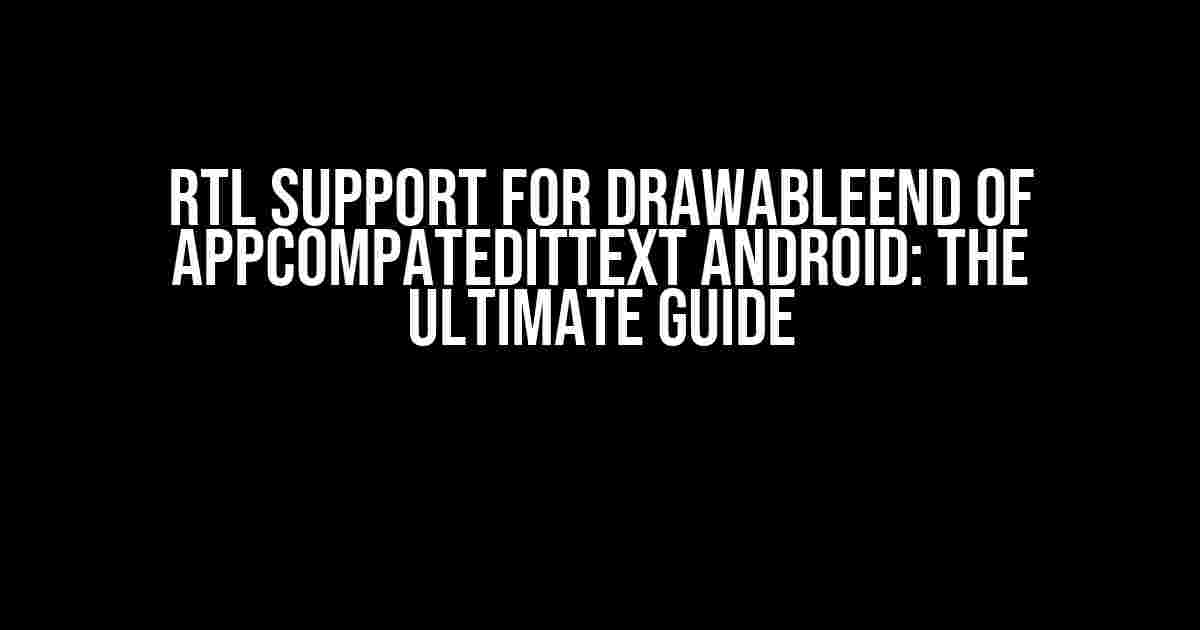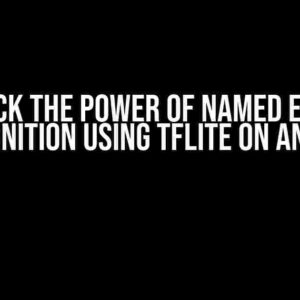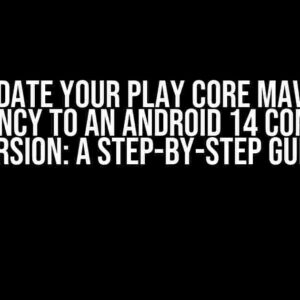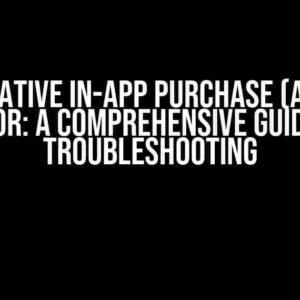Are you tired of struggling with RTL (Right-to-Left) support for the drawableEnd of AppCompatEditText in your Android application? Do you want to provide a seamless user experience for your users who speak languages like Arabic, Hebrew, or Persian? Look no further! This article will take you on a step-by-step journey to master RTL support for drawableEnd of AppCompatEditText in Android.
Why RTL Support Matters
In today’s globalized world, it’s essential to cater to users who speak languages that read from right to left. According to a study, there are over 1.8 billion people who speak RTL languages worldwide. Failing to provide RTL support can lead to a poor user experience, which can negatively impact your app’s rating and eventually, your business.
The Problem with AppCompatEditText
The AppCompatEditText is a powerful component in Android that allows developers to create customized edit text fields with ease. However, when it comes to RTL support, things get a bit tricky. By default, the drawableEnd of AppCompatEditText doesn’t provide RTL support, which means that the drawable (e.g., a clear button) will be displayed on the right side of the edit text field, even when the language is set to RTL.
Solving the RTL Support Issue
Fortunately, there are ways to overcome this limitation. Here are a few approaches to provide RTL support for the drawableEnd of AppCompatEditText:
Method 1: Using Android’s Built-in RTL Support
Starting from Android 4.2 (API level 17), Android provides built-in RTL support for certain views, including the AppCompatEditText. To enable RTL support, you need to add the following attribute to your AppCompatEditText:
<android.support.v7.widget.AppCompatEditText
...
android:layoutDirection="locale"
.../>
This will automatically mirror the drawableEnd of the AppCompatEditText when the language is set to RTL.
Method 2: Using a Custom LayoutDirection
Another approach is to create a custom layout direction for your AppCompatEditText. You can do this by creating a custom attribute:
<declare-styleable name="CustomAppCompatEditText">
<attr name="rtlDrawableEnd" format="boolean"/>
</declare-styleable>
Then, in your custom AppCompatEditText class, override the onLayout() method:
public class CustomAppCompatEditText extends AppCompatEditText {
...
@Override
protected void onLayout(boolean changed, int left, int top, int right, int bottom) {
super.onLayout(changed, left, top, right, bottom);
if (isRtl() && getRtlDrawableEnd()) {
Drawable drawable = getCompoundDrawables()[2];
setCompoundDrawablesWithIntrinsicBounds(null, null, null, drawable);
}
}
...
}
This approach requires more effort, but it provides a high degree of customization and control over the RTL support.
Method 3: Using a Third-Party Library
If you’re short on time or prefer a more straightforward solution, you can use a third-party library like rtl-android. This library provides a set of RTL-enabled views, including an AppCompatEditText with built-in RTL support for the drawableEnd.
To use the rtl-android library, add the following dependency to your build.gradle file:
dependencies {
implementation 'com.github.ali63 rtl-android:1.0.0'
}
Then, simply replace your AppCompatEditText with the RtlAppCompatEditText from the library:
<com.github.ali63.rtl_android.RtlAppCompatEditText
...
android:drawableEnd="@drawable/clear_button"/>
Additional Tips and Tricks
Here are some additional tips and tricks to keep in mind when implementing RTL support for the drawableEnd of AppCompatEditText:
- Test thoroughly: Make sure to test your implementation on different devices and Android versions to ensure that the RTL support works as expected.
- Provide a fallback: If you’re using a custom solution, provide a fallback for devices that don’t support RTL languages.
- Use a consistent design language: Ensure that your app’s design language is consistent across all languages and regions.
- Support bidirectional languages: Don’t forget to support bidirectional languages like Arabic, which require a combination of RTL and LTR text directions.
Conclusion
Providing RTL support for the drawableEnd of AppCompatEditText in Android is crucial for creating a seamless user experience for users who speak RTL languages. By using one of the methods outlined in this article, you can ensure that your app is compatible with a wide range of languages and regions. Remember to test thoroughly, provide a fallback, use a consistent design language, and support bidirectional languages to take your app to the next level.
| Method | Description |
|---|---|
| Using Android’s Built-in RTL Support | Enable RTL support using the android:layoutDirection attribute. |
| Using a Custom LayoutDirection | Create a custom attribute and override the onLayout() method to provide RTL support. |
| Using a Third-Party Library | Use a library like rtl-android to provide RTL support for the drawableEnd of AppCompatEditText. |
By following the instructions and tips outlined in this article, you’ll be well on your way to providing robust RTL support for the drawableEnd of AppCompatEditText in your Android application.
FAQs
Here are some frequently asked questions about RTL support for drawableEnd of AppCompatEditText:
- Q: Does Android provide built-in RTL support for AppCompatEditText?
A: Yes, starting from Android 4.2 (API level 17), Android provides built-in RTL support for certain views, including the AppCompatEditText.
- Q: How do I enable RTL support for the drawableEnd of AppCompatEditText?
A: You can enable RTL support using one of the methods outlined in this article, such as using the
android:layoutDirectionattribute or creating a custom layout direction. - Q: What is the best approach for providing RTL support?
A: The best approach depends on your specific requirements and constraints. However, using a third-party library like
rtl-androidcan provide a quick and easy solution.
By mastering RTL support for the drawableEnd of AppCompatEditText, you can create a more inclusive and user-friendly app that caters to a diverse range of users.
Frequently Asked Question
Got stuck with RTL support for drawableEnd of AppCompatEditText in Android? Don’t worry, we’ve got you covered!
How do I enable RTL (Right-to-Left) support for drawableEnd in AppCompatEditText?
To enable RTL support for drawableEnd in AppCompatEditText, you need to add `android:layoutDirection=”rtl”` to your EditText in the XML layout file. Additionally, make sure your app’s `targetSdkVersion` is 17 or higher, and you’re using AppCompat v23.2.0 or later.
Why is my drawableEnd not displaying correctly in RTL layout?
If your drawableEnd is not displaying correctly in RTL layout, check if you’ve set `android:drawableEnd` instead of `android:drawableRight`. Remember, `drawableEnd` is used for RTL layouts, while `drawableRight` is used for LTR layouts.
Can I use ` Gravity` to align the drawableEnd in RTL layout?
No, you can’t use `Gravity` to align the drawableEnd in RTL layout. Instead, use `android:layoutDirection` and `android:textDirection` to control the layout direction and text direction, respectively.
How do I set a different drawable for RTL layout?
To set a different drawable for RTL layout, you can use a separate drawable resource file with the same name but with a suffix `-rtl`. For example, if your original drawable is `drawable/my_drawable.xml`, create a new file `drawable-rtl/my_drawable.xml` with the RTL-specific drawable.
Will RTL support for drawableEnd work on all Android versions?
RTL support for drawableEnd in AppCompatEditText is available on Android 4.2 (API level 17) and later. However, if you’re using AppCompat, you can use it on Android 2.3 (API level 10) and later, but with some limitations.




